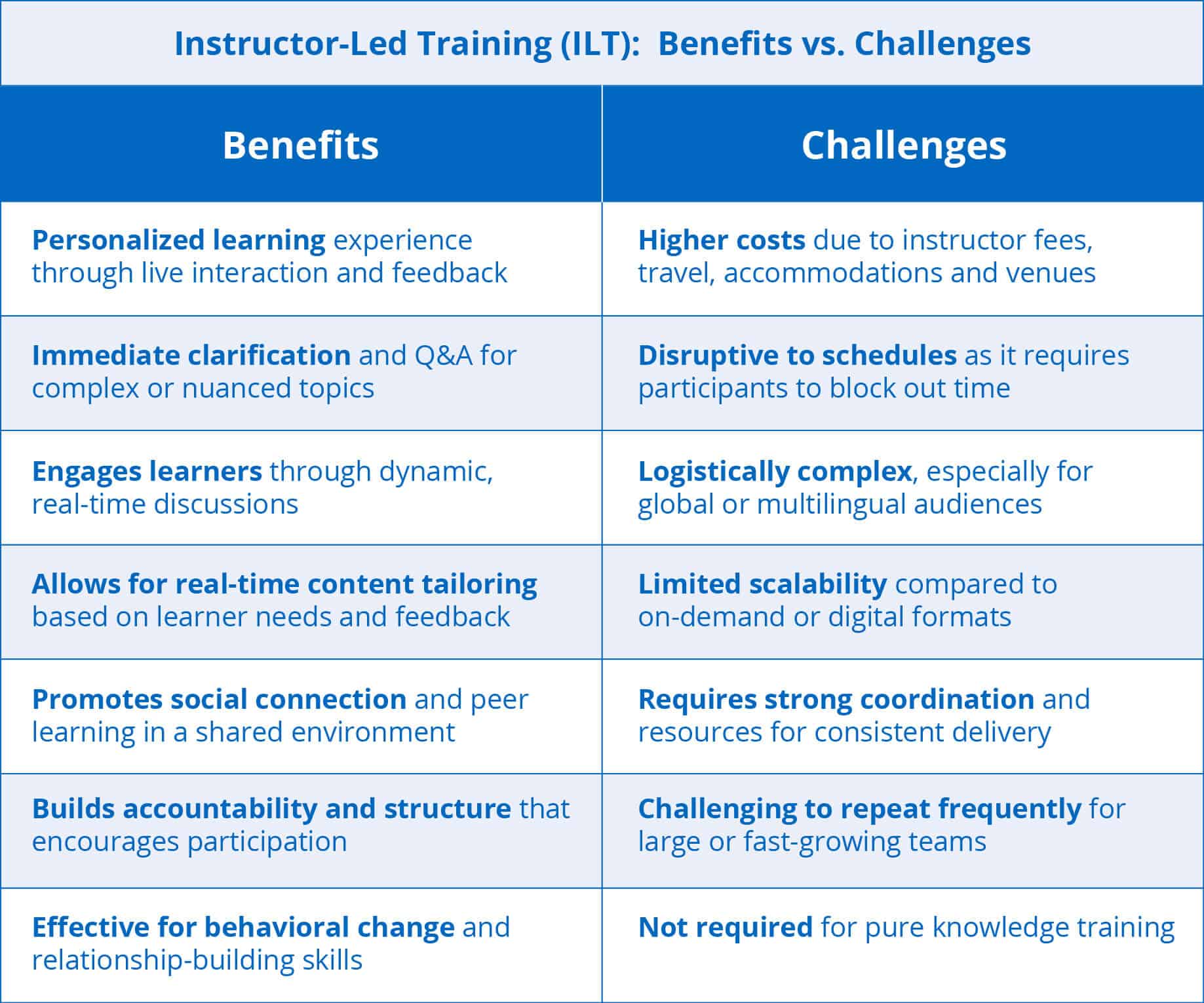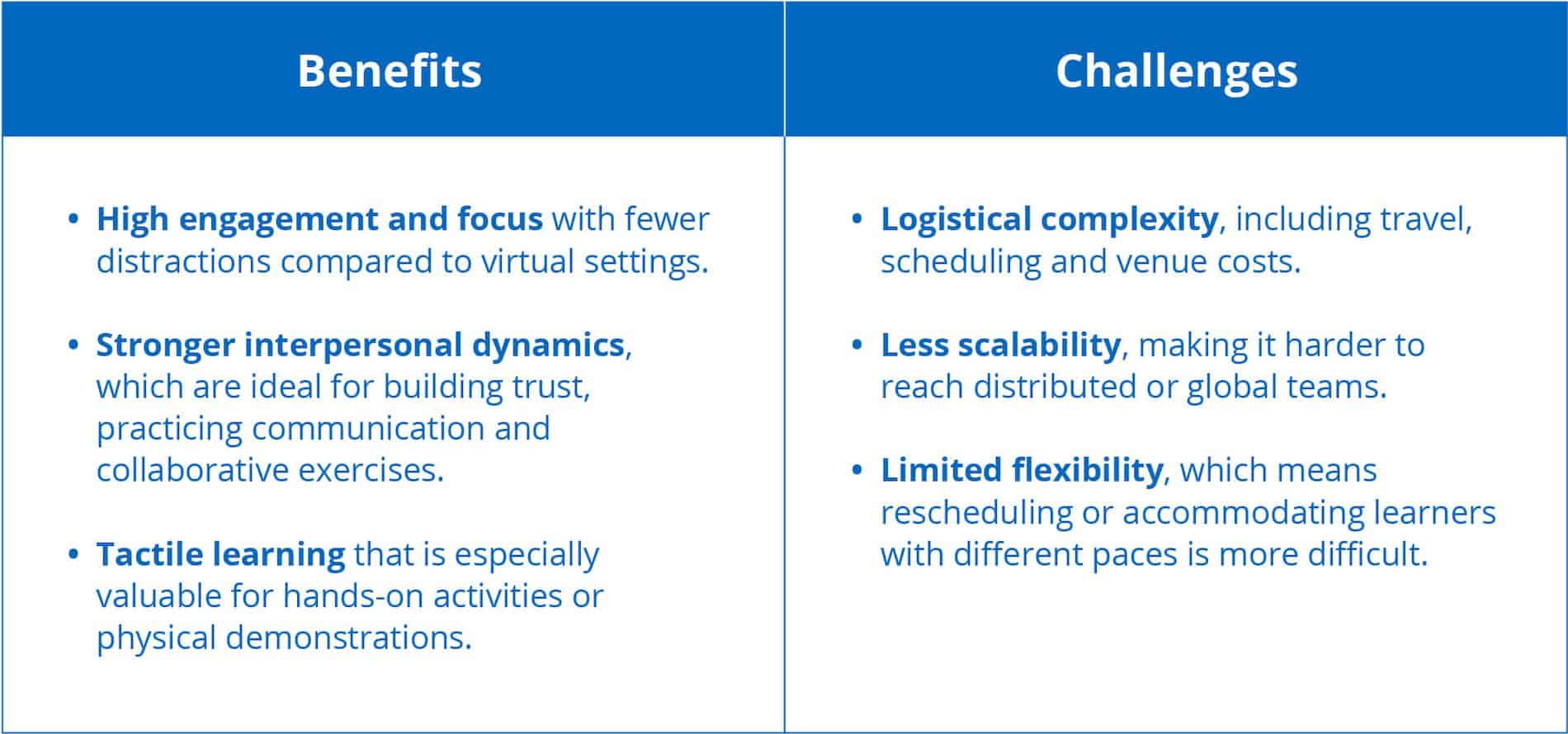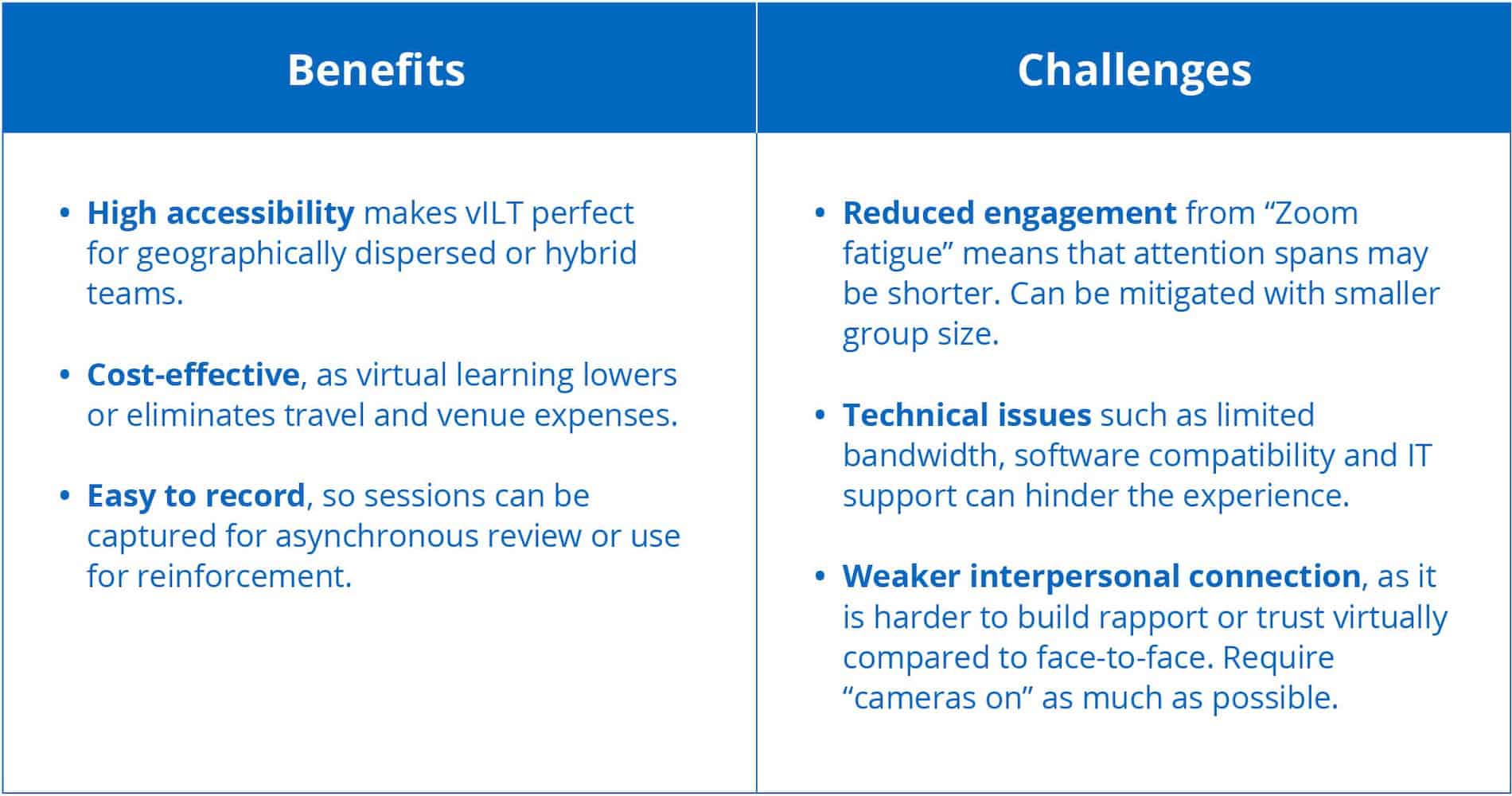
As companies strive to retain and upskill talent and adapt to service-centric business models, they often find that self-service virtual education models aren’t always the right fit for a customer service training program. Some trainings require hands-on, live and direct interaction provided by instructor-led training (ILT).
While ILT can be thought of as “traditional” instruction, don’t dismiss it as being old-fashioned or irrelevant for today’s workplace. ILT is a foundational component of modern workforce development and can be your most effective method for delivering exceptional results.
When you bring subject matter expertise together with interactive learning experiences, you’ll find that delivering engaging, personalized learning opportunities doesn’t have to be limited to digital platforms — provided you understand the best ways to deliver instructor-led training.
Here’s what you need to know.
What Is Instructor-led Training?
We define instructor-led training as a live, interactive learning format in which an instructor or facilitator delivers training content in real time, typically within a structured, classroom-like environment. This can occur in person or virtually, but either way, it always involves real-time human engagement between learners and instructors.
Think of ILT as having a personal trainer for your professional development — the trainer (or trainers) not only imparts knowledge but tailors feedback, corrects misconceptions on the spot and provides guided practice so learners can master complex skills. This high-touch approach is effective when the training involves behavioral change, interpersonal communication or nuanced decision-making.
What Are The Benefits of Instructor-led Training?
What do you find generally more engaging? Watching a recording of an event, or being there and participating live? That dynamic is key to the benefits of using instructor-led training, which include:
- Flexibility for Meeting Unique Customer Needs and Complex Products ILT is easily adapted to specific roles, industries and complex product scenarios, making it ideal for companies with custom use cases or multiple applications. Skilled instructors can tailor examples and adjust depth on the fly for better relevance and to meet learners where they are.
- Enhanced Learner Engagement Live interaction keeps learners actively involved through discussion, exercises and real-time feedback, leading to stronger focus and emotional investment compared to passive formats like e-learning. This is particularly valuable when teaching interpersonal skills or for behavior-based training programs.
- Immediate Clarification and Discussion Participants can ask questions and get clarification in real time, preventing misunderstandings and reinforcing learning. This ability to pause and ask the instructor “why?” is critical for mastering nuanced or complex concepts.
- Real-Time Training Customization Through Learner Feedback Instructors and facilitators can adapt sessions in the moment based on learner feedback, adjusting pace, adding examples or diving deeper into areas of confusion. This adaptability not only better meets the group’s evolving needs, but it also ensures training objectives are met effectively.
- A Focused Learning Environment That Builds Accountability ILT sessions create dedicated, distraction-free learning time, enhancing focus and accountability. This structure encourages participants to actively prepare, contribute and follow through on learning commitments, helping them stay on track and prioritize their development.
- Greater Support for Social Connection and Peer Learning ILT fosters a collaborative environment where learners connect, share insights and learn from one another — building team trust and support that extends beyond training. These interactions are important in leadership and field service roles, where relationship-building and communication are core competencies
- Structure, Responsibility and Personal Connection ILT offers direct access to instructors, creating a sense of support, responsibility and personal connection. This personal connection helps build trust, which is crucial for behavior change. Participants often describe ILT as “motivating” and “eye-opening” because of the direct encouragement and individualized attention they receive.
Instructor-led Training Tips from GPT Facilitators
The facilitators who work with Global Partners Training are all skilled in providing direction and engaging learners with the course content. Here are some examples of techniques GPT facilitators have employed to maximize ILT benefits:
“During the pre-program preparation, I reached out to connect with every participant. We were able to effectively use that time to answer their questions on the details of the program logistics.”
“I take the time to encourage the participants to ‘re-teach’ the tools back to each other. This technique is a very effective way to ensure participants master the tools in addition to validating the impact of knowledge.”
“When you see that participants know each other to different degrees, that’s a great opportunity to get them to engage and use the program to learn from each other. That made it easier for them to share ongoing work discussions that went beyond the program content, which positively contributed to the learning process.”
“Peer coaching activities are perfect for professional development training. Pair groups so that someone with more knowledge is able to coach their partner. That helps reinforce learning for both individuals. You can even take the group outside and for a walk and ask them to peer coach on the move — that makes it more like taking a walk with a new friend, which helps make the training fresh, different, and visible.”
What Are The Drawbacks of Instructor-led Training?
While ILT is highly effective, it’s important to understand its limitations. That way, your team can align your training strategies with the organizational realities.
Higher Costs and Resource Requirements
ILT costs may include instructor fees, venue rentals, printed materials, travel, accommodations, meals and administrative support. For organizations training large, distributed teams, overhead costs can be mitigated somewhat by using outsourced providers on a strategic or tactical basis.
When it matters: ILT may not be the first choice for organizations operating on tight training budgets or that need frequent training sessions, although it is generally considered the most impactful approach for soft skills training where behavior change is expected.
Scheduling Disruptions and Time Commitment
ILT requires participants step away from their regular duties during scheduled training blocks, which can disrupt workflows, especially in customer-facing or field-service roles where coverage is essential. Unlike self-paced learning, ILT leaves less room for schedule flexibility.
When it matters: In fast-paced environments with lean staffing or unpredictable workloads, carving out time for group sessions may be challenging and reduce operational efficiency. Here it is important to understand the compensating business value expected from the training.
Logistical Complexities
Coordinating ILT can be demanding, particularly for global or multilingual teams. Challenges include finding suitable times across time zones, aligning with regional holidays and ensuring all materials are accessible to speakers of different languages and are culturally appropriate.
When it matters: For global rollouts or programs with highly diverse learner populations, these logistics can delay training and reduce consistency in delivery. Consider local and/or global outsourced solutions to meet this challenge.
Limited Scalability
ILT’s live, synchronous nature means it doesn’t scale as easily as digital learning. An instructor can only work with a limited number of learners at a time, and duplicating sessions increases costs and strains resources. It may also restrict the speed at which new hires or teams can be trained.
When it matters: Organizations experiencing rapid growth or high turnover may struggle to keep up with demand using ILT alone, making a blended approach more viable.
ILT is best deployed when high-touch interaction is critical, the training is expected to impact organizational culture, or it is intended to change behaviors. It’s most applicable when the audience is high-impact or customer-facing (i.e. sub-optimal behaviors are costing real money). For other scenarios, such as basic onboarding or repetitive knowledge training, self-paced eLearning or microlearning can offer greater scalability and cost efficiency.
However, there are ILT formats that help to mitigate some of its challenges by using technology to reduce logistics and costs while increasing scalability.
What Formats Can Instructor-led Training Take?
Instructor-led training is highly adaptable, and you can take different approaches to meet diverse learning needs and adapt to different environments. There are three primary delivery formats: in-person, virtual and blended/hybrid learning.
1. In-Person Instructor-led Training (Classroom-Based Learning)
In-person ILT is conducted in a physical classroom setting where a live instructor engages with learners face-to-face. Learners benefit from real-time interaction not only with the instructor but also with peers, making it ideal for practicing communication, teamwork and hands-on skills in a highly interactive environment.
Technology/Environment Required:
- Training room with seating, projectors/screens and audio-visual tools
- Printed manuals, handouts or props for exercises
- Optional digital polling or collaboration tools can further enhance engagement
2. Virtual Instructor-led Training (vILT or Live Online Learning)
Virtual instructor-led training takes place over video conferencing platforms, enabling participants to join remotely from different locations. A live instructor leads the session in real time, using digital tools. Although remote, vILT can still foster dynamic participation and collaborative learning when designed effectively, making it a strong option for distributed teams.
Technology/Environment Required:
- Stable internet connection, webcam and a microphone/headset
- Virtual meeting platforms with screen sharing, breakout room functionality and engagement tools
- Digital course materials such as PDFs, slides and online polls
3. Blended or Hybrid Instructor-led Training
Blended ILT formats combine the structure of instructor-led sessions with the flexibility of online learning. In-person and virtual live sessions for skill application and discussion may be supported by self-paced digital content to build foundational knowledge. This format often includes post-training reinforcement through coaching or group activities, creating a continuous learning journey that adapts to various learning styles and schedules.
Technology/Environment Required:
- Learning Management System (LMS) for digital content delivery and tracking
- Virtual conferencing tools and/or in-person space
- Coordination tools for scheduling and learner management
Challenges
- Provides flexibility and scalability that meet a variety of learner needs and availability.
- Reinforces learning by layering different formats to improve retention and skill application.
- Promotes learner autonomy through self-paced components that empower learners to learn at their speed between group sessions.
- Higher complexity that requires careful coordination and integration of content across different formats.
- Weak manager support and lack of accountability put learners at risk of disengaging during multi-step programs.
- More planning and technology are required for success, including a strong LMS and support structure.
Did You Know? Global Partners Training often uses a blended approach in programs like Total Customer Focus™, combining self-paced e-learning, live workshops (virtual or in-person) and follow-up coaching. This structure maximizes flexibility while ensuring deep, behavioral learning outcomes across diverse global teams.
What Are The Different Types of Instructor-led Training?
Aside from the delivery format, there are also different methods of engaging in ILT, from smaller one-on-one coaching sessions up to large-format virtual instructor-led training webinars. Each method has its particular purpose and utility.
- One-on-One Coaching Personalized, confidential sessions between a coach or instructor and an individual learner that focus on building specific skills, addressing performance challenges or supporting professional development.
- Small Group Sessions Intimate training format with 2–10 participants, offering high levels of interaction, discussion and peer learning. Ideal for team alignment, role-based learning and practical application.
- Workshops Hands-on, immersive training experiences that typically last a half-day or more. Workshops combine instruction with group exercises, role-playing and real-time problem solving for skill development or strategic planning.
- Seminars Structured, presentation-style learning sessions are usually delivered to a medium-to-large audience. Designed primarily for knowledge transfer, with limited interaction beyond Q&A or breakout activities.
- Webinars Live, virtual seminars are conducted online using video conferencing platforms. Useful for reaching geographically dispersed audiences and sharing information efficiently, with moderate opportunities for engagement through chat, polls or breakout rooms.
ILT Methods and When to Use Them
| Method | Group Size | Interaction Level | Best For |
| One-on-One Coaching | 1 | Very High | – Leadership development – Performance improvement – Executive training |
| Small Group Sessions | 2–10 | High | – Team alignment – Role-based skills training – Customer-facing roles |
| Workshops | 6–25 | High to Moderate | – Deep skill-building – Strategic planning – Change management |
| Seminars | 25–100+ | Moderate to Low | – Product rollouts – Market education – Compliance – Industry trends |
| Webinars | Unlimited (practical max ~200) | Low to Moderate | – Remote training – Global audiences – Customer education |
What Are Some Ways to Keep Participants Engaged During Instructor-led Training?
Maintaining engagement is essential to maximizing the effectiveness of instructor-led training — especially when you want to build customer-facing skills, drive behavior change or align cross-functional teams. Whether you’re delivering training in-person or virtually, ensuring learners feel heard and challenged is what transforms passive instruction into immersive learning experiences.
Here are recommended tips and best practices to keep participants actively involved throughout ILT sessions:
- Use Interactive Elements to Drive Participation
- Conduct live polls or real-time quizzes to gauge understanding, spark discussion and keep energy levels high.
- Divide participants into smaller groups for brainstorming, peer coaching or scenario exercises. This increases participation and gives quieter learners a voice.
- Simulate real-world interactions such as customer complaints and leadership coaching to allow learners to practice skills and receive constructive feedback in a safe environment.
- Incorporate Real-World Scenarios
- Use case studies and job-relevant situations that mirror the challenges learners face daily. This makes training content relatable and immediately applicable.
- Encourage learners to bring in their own challenges or experiences, and guide the group in solving them collaboratively.
- Tailor scenarios to different roles or industries when training cross-functional or global teams.
- Leverage Multimedia Tools to Vary Content Delivery
- Use videos, animations or customer testimonials to break up lectures and illustrate key points.
- Display visual frameworks or infographics to summarize complex concepts and improve retention.
- Share interactive whiteboards, tablets or similar devices to allow groups to collaborate on exercises or idea generation.
- Foster Collaborative Discussions
- Use open-ended questions and prompts that encourage learners to reflect, share opinions or challenge assumptions.
- Design activities that require group input, such as ranking priorities, completing a task together or offering peer feedback.
- Always make an effort to acknowledge contributions and encourage a psychologically safe environment where learners feel valued and heard.
What Are Some Skills and Qualities That Make for a Good ILT Instructor?
All ILT instructors, whether HR professionals, training managers or program developers, are capable of delivering effective and engaging training sessions if they master a few essential skills.
If you’re running your own training sessions, ensure you’re providing professional development resources so your trainers can develop these skills. Or, if you’re working with a training partner, ensure that they value and prioritize the following qualities:
- Strong Communication Skills The ability to clearly articulate concepts, instructions and feedback in a way that is engaging, accessible and tailored to diverse learner groups.
- Time Management Balancing depth with pacing ensures all objectives are met within time constraints while still allowing for discussion and interaction.
- Facilitation Skills The ability to guide discussions, manage group dynamics and encourage participation without dominating the conversation. Great facilitators create space for learners to discover insights on their own.
- Empathy Understanding and valuing the learner’s perspective, challenges and emotional state. Empathetic instructors build trust, encourage participation and create a safe learning environment.
- Active Listening Truly hearing what learners say (and don’t say) enables instructors to respond thoughtfully, validate perspectives and tailor their approach to meet evolving learner needs.
- Adaptability The flexibility to adjust pacing, content or delivery style in response to group dynamics, unexpected questions or technical issues.
- Deep Subject Matter Expertise Mastery of the training content builds credibility and allows instructors to confidently field questions, connect concepts to real-world applications and offer meaningful insights.
- Ability to Read and Respond to Learner Cues A strong instructor can “read the room” and pivot accordingly, whether by adjusting tone, revisiting material or prompting discussion.
- Cultural Intelligence Sensitivity to cultural differences in communication, learning preferences and engagement styles is critical, especially when delivering training to global or cross-functional teams.
- Curiosity and Continuous Learning Great instructors stay curious about their learners, their subject matter and new instructional techniques. They’re open to feedback and committed to improving their delivery.
How to Choose an Instructor-Led Training Program Partner
Selecting a training provider should go beyond simply trying to fill a knowledge gap. If you’re hoping for sustainable outcomes, then you need a partner who can deliver a transformative learning experience. Whether you’re training field service teams, leadership or cross-functional groups, here are five key criteria to evaluate when choosing a partner:
Industry Expertise
Look for a partner who understands your sector’s challenges, terminology and customer expectations. Providers with experience in your industry will offer more relevant scenarios, examples and best practices and can more effectively prepare your team to meet real-world demands.
Tip: Ask if they’ve worked with companies of your size or complexity.
Instructional Design Capabilities
The best training providers go beyond content delivery by designing entire experiences. Evaluate their ability to build structured, engaging ILT sessions that include role-playing, discussion and reinforcement. Do they customize content to different learner roles and objectives? Are their methods grounded in adult learning principles?
Tip: Ask to review a sample agenda or session design.
Technology Platform and Hybrid Flexibility
A modern training partner should offer flexible delivery, including a choice of in-person, virtual and blended formats. Evaluate their use of digital communication platforms or custom LMS systems. Can they support hybrid teams? Do they offer asynchronous materials, digital reinforcement or coaching options?
Tip: Check how they incorporate digital tools into courses; they should be used not only to disseminate information, but also to reinforce learning and in-the-field action.
Cultural Fit and Real-World Relevance
Your training partner should align with your company values and learning culture. Do they prioritize real-world application, not just theory? Can they relate to your workforce across global teams, roles or experience levels? Look for partners who emphasize trust-building, empathy and long-term behavior change.
Tip: Ask for client testimonials that reflect your company’s context.
Proven Outcomes
Credible training providers can demonstrate ROI. Ask for evidence of impact such as improved customer satisfaction, productivity, retention or revenue growth. Do they collect success cases? Can they quantify results? Strong partners will have metrics, case studies or client quotes to support their claims.
Tip: Ask how they help you measure success after training.
The best partners will challenge your thinking, engage your learners and support your goals with measurable, human-centered training that sticks. Don’t settle for “good enough” — watch out for the following red flags to choose the right ILT partner:
|
|
How to Create an Impactful Instructor-Led Training Program
Collaborating with the right training partner is key — but to ensure your ILT program delivers measurable results, it needs to be purposefully designed around your workforce’s needs, learning goals and business strategy. Here’s how to do it:
- Perform a Needs Assessment and Audience Analysis Start by identifying your pain points and training gaps. Interview stakeholders, survey learners and analyze performance data to better understand the job roles, cultural context and challenges your audience faces. A great training provider will support this discovery process to help shape a targeted solution.
- Set Clear Objectives and Content Requirements Define what success looks like. Are you aiming to improve customer satisfaction, service sales results, develop frontline leaders, get two departments to work better together, or reduce escalations? You’ll need to translate business needs into specific learning outcomes and then align content with real-world scenarios learners encounter daily.
- Design the Curriculum for Diverse Learners Ensure that content will resonate across different functions, roles and geographies. This can include a mix of customized interactive elements like role-playing, group work and digital reinforcement as well as storytelling and real-world examples to increase retention. Make an effort to ensure accessibility across languages and learner preferences.
- Deliver the Content with Active Learning Changing behaviours requires that sessions are engaging, not just informative. Great ILT includes discussions, case study analysis and peer collaboration delivered by trained facilitators to keep learners engaged and focused. Remember that, between virtual and blended formats, neither is “better” than the other, and there are far more similarities than differences.
- Evaluate Progress to Maximize Value The training framework must be architected to build on what’s working and fix what isn’t. Use pre- and post-training assessments, on-the-job application of new skills, journaling, success cases and observational feedback to measure knowledge transfer, behavior change and business impact. A good partner will help you collect and interpret these insights.
- Use Both Quantitative and Qualitative Feedback It’s important to track participation rates, completion scores and survey data, but it’s equally critical to also gather personal reflections and learner stories. This combination reveals not only what was learned, but how it’s being applied, as well. Use the feedback to refine content and strengthen future sessions.
At Global Partners Training, we specialize in designing service-forward, interactive, industry-specific training programs that drive behavior change and business results. Whether you’re developing service leadership, service excellence or customer relationship skills, our approach blends deep subject matter expertise, flexible delivery formats and measurable outcomes.
Frequently Asked Questions
What is an example of instructor-led training?
An example of ILT is a live workshop where a facilitator teaches a group of service engineers how to handle customer escalations using role-playing, hand-on application, group discussion and real-time feedback to reinforce new behaviors.
What are the benefits of instructor-led training?
ILT offers real-time interaction, personalized feedback, higher engagement and a structured learning environment. It’s especially effective for teaching soft skills, resolving complex topics and supporting behavior change.
What is a disadvantage of instructor-led training?
A major challenge of ILT is its higher cost and logistical complexity due to travel, instructor fees and scheduling. It’s also less flexible, as it requires participants to be present at a specific time.
What is the difference between instructor-led and self-paced training?
The biggest difference is that ILT involves live sessions with real-time interaction between instructors and learners, while self-paced training allows learners to complete materials on their own schedule without live facilitation.
Is instructor-led training cost effective?
While ILT is generally more expensive and less scalable than pure digital formats, it produces much better results when targeting behavior change in high-impact roles or strategic learning goals. ILT provides value through deeper engagement with training concepts and long-term habit formation.





